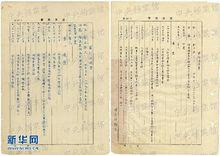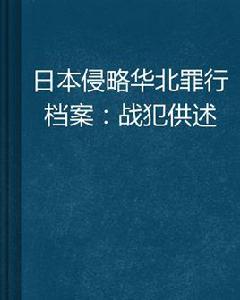公布方式
中央檔案館為了很好的保存這些檔案,檔案館在收集、整理、鑑定作了很多的工作,從2014年7月3日開始公布45個戰犯的筆供,一天公布一個,45天完畢。
 日本侵華罪行筆供
日本侵華罪行筆供檔案館正在著手進行沒有被判刑的1017名日本戰犯的筆供,有的沒有被判刑並予以釋放,在偵查起訴過程中,每個人也都是有筆供的,是當時作了中文的翻譯,正在著手整理這些檔案。
公布完這些以後,按照檔案館的安排,因為數量非常之大,加以整理在適當的時候以適當的形式公布。中央檔案館館藏偵查起訴、處理日本戰犯的檔案,僅僅就戰犯的筆供而言,數量就將近有20萬頁。
公布內容
這次公布的日本戰犯的侵華罪行筆供,包括原文、譯文,並把提要翻譯成了英文。從筆供內容來看,這些日本戰犯在中國犯下的罪行主要有:策劃、推行侵略政策、製造細菌武器、施放毒氣、進行活體試驗、屠殺掠奪資財、毀滅城鎮、強征慰安婦、強姦婦女,驅逐和平居民很多違反國際準則和人道主義原則的種種罪行。
主要目的
中央檔案館一直很好地保管這些檔案,目的有兩個:一是把這些檔案適時的通過各種方式公布出來,提供給社會各界來利用,讓人們看到日本侵略者的暴行。同時,也要把這些檔案很好的保存下去,為警示中國後代。
公布背景
1945年8月14日,日本天皇裕仁發錶停戰詔書,宣布日本無條件投降。根據《波茨坦公告》,中、美、英、蘇等11個國家組成遠東國際軍事法庭,對發動侵華戰爭和太平洋戰爭負有戰爭責任的東條英機等日本戰犯進行了審判。
新中國誕生後,接管和關押的日本侵華戰犯達1109名,分別關押在撫順、太原兩地。
1954年,中央人民政府最高人民檢察署(後改稱中華人民共和國最高人民檢察院)負責對日本侵華戰犯的偵查、起訴工作,對他們在侵略中國戰爭中侵奪中國主權,策劃、推行侵略政策,進行特務間諜活動,製造細菌武器,施放毒氣,屠殺、抓捕、奴役和毒化中國人民,強姦婦女,掠奪物資財物,毀滅城鎮鄉村,驅逐和平居民,違反國際準則和人道主義原則等各種罪行進行了審訊。
 日本侵華罪行筆供
日本侵華罪行筆供1956年4月25日全國人大常委會通過的《關於處理在押日本侵略中國戰爭中犯罪分子的決定》,中華人民共和國最高人民檢察院於1956年先後分三批對在押的1017名罪行相對較輕、悔罪表現較好的日本侵華戰犯宣布免予起訴,並立即釋放。同時,對職務較高、罪行較重的45名日本侵華戰犯,向中華人民共和國最高人民法院特別軍事法庭提起公訴(其餘47名戰犯在關押期間死亡)。
1956年6月至7月,中華人民共和國最高人民法院特別軍事法庭分別在瀋陽、太原對鈴木啟久等45名戰犯進行了公開審判,並根據被告人的犯罪事實、犯罪情節、悔罪表現等情況,按照全國人大常委會的決定,實行從寬處理,分別判處了二十年至八年有期徒刑。
有關全國人大常委會、最高人民檢察署(院)、最高人民法院特別軍事法庭審判日本侵華戰犯的檔案,現保存在中央檔案館。檔案卷宗內各個戰犯自己的書面筆供以及詳細的審訊筆錄等材料,是日本軍國主義侵略者對中國人民所犯滔天罪行的鐵證。
日本安倍內閣上台以後,公然顛倒黑白、混淆視聽,美化對外侵略和殖民歷史。這是對歷史正義和人類良知的漠視,也是對二戰成果和戰後國際秩序的挑戰。在盧溝橋事變77周年之際,中央檔案館從館藏檔案中選取了經最高人民法院審判的45名日本戰犯的親筆供詞,包括筆供原文、補充、更正、附言等以及當時的中文譯文並附提要,一併向社會公布,揭露日本侵華期間的反人道、反人類、反文明暴行。
英文說明
Introduction
On August14 1945, Emperor Hirohito of Japan issued an imperial edict on armistice, announcing Japan's unconditional surrender. In accordance with the Potsdam Proclamation, the International Military Tribunal for the Far East was formed by 11 countries, including China, the United States, the United Kingdom and the Soviet Union, and had trials on Hideki Tojo and other Japanese war criminals responsible for launching the Japanese War of Aggression against China and the Pacific War.
After the birth of New China, a total of 1,109 Japanese war criminals were taken over and held in custody in the two places of Fushun and Taiyuan. In 1954, the Supreme People's Procuratorate Office of the Central People's Government (later renamed the Supreme People's Procuratorate of the People's Republic of China) was responsible for the investigation and prosecution of the Japanese war criminals. It had trials on their crimes committed during the Japanese War of Aggression against China, including violating China's sovereignty, planning and implementing the policy of aggression, conducting spy and espionage activities, manufacturing bacteria weapons, releasing poison gas, killing, arresting, enslaving and poisoning the Chinese people, raping women, plundering money and materials, destroying towns and villages, expelling peaceful inhabitants, and violating international norms and humanitarian principles.
According to the Decision on the Handling of the Criminals in Custody from the Japanese War of Aggression against China adopted by the Standing Committee of the National People’s Congress (NPC) on 25 April 1956, the Supreme People's Procuratorate of the People's Republic of China announced the decision to exempt from prosecution and immediately release, in three batches in 1956, a total of 1,017 Japanese war criminals in custody, who had relatively minor offenses and good behaviors of repentance. Meanwhile, a public prosecution was initiated to the Special Military Tribunal of the Supreme People's Court of the People's Republic of China on 45 Japanese war criminals, who were of higher positions and heavier offenses (the other 47 war criminals died in custody).
From June to July 1956, the Special Military Tribunal of the Supreme People's Court of the People's Republic of China publicly tried in Shenyang and Taiyuan the 45 war criminals including Suzuki Keiku, and, based on the defendants' criminal facts, circumstances of the crimes, repentance, etc., treated them with leniency in accordance with the decision of the NPC Standing Committee, sentencing them to from twenty years to eight years in prison respectively.
Archives related to the trials of the war criminals of the Japanese War of Aggression against China, such as documents issued by the NPC Standing Committee, the Supreme People's Procuratorate and the Special Military Tribunal of the Supreme People's Court, are stored in the Central Archives. The confessions written by all the war criminals and the detailed trial records contained in the archive files are irrefutable evidence of the heinous crimes committed by the Japanese militarist aggressors against the Chinese people.
Since the Abe cabinet came into power in Japan, it has openly confused right and wrong to mislead the public, in an attempt to whitewash the history of external aggression and colonialism. This is a total disregard of the historical justice and human conscience, as well as a challenge to the outcome of World War II and the post-war international order. On the occasion of the 77th anniversary of the Marco Polo Bridge Incident, we at the Central Archives have selected from the archive files the written confessions of the 45 Japanese war criminals tried by the Supreme People's Court, including the original texts of the written confessions, supplements, corrections, postscripts, etc. as well as the then Chinese translations with abstracts, to release to the general public, in order to expose the anti-humanitarianism, anti-humanity, and anti-civilization atrocities during the Japanese invasion of China.
The past, if not forgotten, can serve as a guide for the future. Only by truly remembering the history and learning from the history, can we avoid a repeat of the tragedy of war and achieve real and lasting peace and stability in the world.

